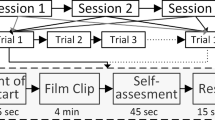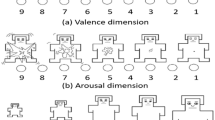Abstract
Emotion recognition based on electroencephalography (EEG) is attracting more and more interest in affective computing. Previous studies have predominantly relied on manually extracted features from EEG signals. It remains largely unexplored in the utilization of raw EEG signals, which contain more temporal information but present a significant challenge due to their abundance of redundant data and susceptibility to contamination from other physiological signals, such as electrooculography (EOG) and electromyography (EMG). To cope with the high dimensionality and noise interference in end-to-end EEG-based emotion recognition tasks, we introduce a Two-Stream Spectral-Temporal Denoising Network (TS-STDN) which takes into account the spectral and temporal aspects of EEG signals. Moreover, two U-net modules are adopted to reconstruct clean EEG signals in both spectral and temporal domains while extracting discriminative features from noisy data for classifying emotions. Extensive experiments are conducted on two public datasets, SEED and SEED-IV, with the original EEG signals and the noisy EEG signals contaminated by EMG signals. Compared to the baselines, our TS-STDN model exhibits a notable improvement in accuracy, demonstrating an increase of 6% and 8% on the clean data and 11% and 10% on the noisy data, which shows the robustness of the model.
Access this chapter
Tax calculation will be finalised at checkout
Purchases are for personal use only
Similar content being viewed by others
References
Lorach, H., Galvez, A., Spagnolo V., Martel, F., et al.: Walking naturally after spinal cord injury using a brain-spine interface. Nature 1–8 (2023)
Alarcao, S.M., Fonseca, M.J.: Emotions recognition using EEG signals: a survey. IEEE Trans. Affect. Comput. 10(3), 374–393 (2017)
Supriya, S., Siuly, S., Wang, H., Zhang, Y.: Epilepsy detection from EEG using complex network techniques: a review. IEEE Rev. Biomed. Eng. 16, 292–306 (2021)
Vaswani, A., Shazeer, N., Parmar, N.: Attention is all you need. In: Advances in Neural Information Processing Systems (NeurIPS), pp. 5998–6008 (2017)
Ronneberger, O., Fischer, P., Brox, T.: U-Net: convolutional networks for biomedical image segmentation. In: Navab, N., Hornegger, J., Wells, W.M., Frangi, A.F. (eds.) MICCAI 2015. LNCS, vol. 9351, pp. 234–241. Springer, Cham (2015). https://doi.org/10.1007/978-3-319-24574-4_28
Simonyan, K., Zisserman, A.: Two-stream convolutional networks for action recognition in videos. In: Advances in Neural Information Processing Systems (NeurIPS), pp. 568–576 (2014)
Chollet, F.: Xception: deep learning with depthwise separable convolutions. In: Proceedings of the IEEE Conference on Computer Vision and Pattern Recognition (CVPR), pp. 1251–1258 (2017)
Zhang, H., Zhao, M., Wei, C., Mantini, D., Li, Z., Liu, Q.: EEGdenoiseNet: a benchmark dataset for deep learning solutions of EEG denoising. J. Neural Eng. 18(5), 056057 (2021)
Lawhern, V.J., Solon, A.J., Waytowich, N.R., Gordon, S.M., Hung, C.P., Lance, B.J.: EEGNet: a compact convolutional neural network for EEG-based brain-computer interfaces. J. Neural Eng. 15(5), 056013 (2018)
Zheng, W.L., Lu, B.L.: Investigating critical frequency bands and channels for EEG-based emotion recognition with deep neural networks. IEEE Trans. Auton. Ment. Dev. 7(3), 162–175 (2015)
Zheng, W.L., Liu, W., Lu, Y., Lu, B.L., Cichocki, A.: Emotionmeter: a multimodal framework for recognizing human emotions. IEEE Trans. Cybern. 49(3), 1110–1122 (2018)
Hochreiter, S., Schmidhuber, J.: Long short-term memory. Neural Comput. 9(8), 1735–1780 (1997)
Paszke, A., et al.: Automatic differentiation in pytorch (2017)
Duan, R.N., Zhu, J.Y., Lu, B.L.: Differential entropy feature for EEG-based emotion classification. In: 2013 6th International IEEE/EMBS Conference on Neural Engineering (NER), pp. 81–84. IEEE (2013)
Tao, W., et al.: EEG-based emotion recognition via channel-wise attention and self attention. IEEE Trans. Affect. Comput. 14(1), 382–393 (2023)
Cui, H., Liu, A., Zhang, X., Chen, X., Wang, K., Chen, X.: EEG-based emotion recognition using an end-to-end regional-asymmetric convolutional neural network. Knowl.-Based Syst. 205, 106243 (2020)
Li, R., Wang, Y., Zheng, W.L., Lu, B.L.: A multi-view spectral-spatial-temporal masked autoencoder for decoding emotions with self-supervised learning. In: Proceedings of the 30th ACM International Conference on Multimedia, pp. 6–14 (2022)
Acknowledgments
This work was supported in part by grants from National Natural Science Foundation of China (Grant No. 61976135), STI 2030-Major Projects+2022ZD0208500, Shanghai Municipal Science and Technology Major Project (Grant No. 2021SHZDZX), Shanghai Pujiang Program (Grant No. 22PJ1408600), Medical-Engineering Interdisciplinary Research Foundation of Shanghai Jiao Tong University “Jiao Tong Star” Program (YG2023ZD25), and GuangCi Professorship Program of RuiJin Hospital Shanghai Jiao Tong University School of Medicine.
Author information
Authors and Affiliations
Corresponding author
Editor information
Editors and Affiliations
Rights and permissions
Copyright information
© 2024 The Author(s), under exclusive license to Springer Nature Singapore Pte Ltd.
About this paper
Cite this paper
Liu, XH., Jiang, WB., Zheng, WL., Lu, BL. (2024). Two-Stream Spectral-Temporal Denoising Network for End-to-End Robust EEG-Based Emotion Recognition. In: Luo, B., Cheng, L., Wu, ZG., Li, H., Li, C. (eds) Neural Information Processing. ICONIP 2023. Lecture Notes in Computer Science, vol 14449. Springer, Singapore. https://doi.org/10.1007/978-981-99-8067-3_14
Download citation
DOI: https://doi.org/10.1007/978-981-99-8067-3_14
Published:
Publisher Name: Springer, Singapore
Print ISBN: 978-981-99-8066-6
Online ISBN: 978-981-99-8067-3
eBook Packages: Computer ScienceComputer Science (R0)




